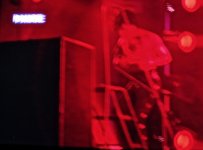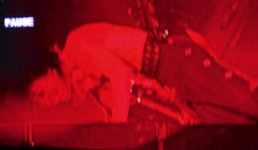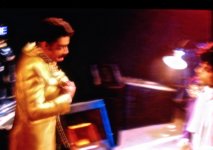Although many have suggested concrete block walls are needed to "contain" LF, the measured results using 1.5" x 1.5" braced 1/2" plywood have shown that it is an effective boundary, as the radiated forward force imparted on said boundary is a small fraction of the forces contained within the tapped horn enclosure.Art, I can't thank you enough. Talk about missing the forest.
Last question for now than is - 1/2" ply with some 2x4 beams ran across the back is my plan.
Obviously, flex is bad. How bad?
Are your Keystones "Purple", or "Turbo Blue"?
Cheers,
Art
(My speakers were humped in "Purple Rain")
Welter
Jones, nice build! That is some serious firepower.
For some reason I am still enamored with w bins and horizontal array with v plating is about equally as cool. My mind is cranking v plate adapters at warp speed. One in particular would be with various rounded ribs running parallel to the mouth almost like the interior of an acoustic guitar (mostly for visual effect).
Art, can a sub and subsequent system (2 subs plus plate) be designed in such a way the v plate alignment would actually yield a lower corner than otherwise of a single sub? In other words, a single would be say 40 but v plated would get you 30? Maybe needs to be FLH?
For some reason I am still enamored with w bins and horizontal array with v plating is about equally as cool. My mind is cranking v plate adapters at warp speed. One in particular would be with various rounded ribs running parallel to the mouth almost like the interior of an acoustic guitar (mostly for visual effect).
Art, can a sub and subsequent system (2 subs plus plate) be designed in such a way the v plate alignment would actually yield a lower corner than otherwise of a single sub? In other words, a single would be say 40 but v plated would get you 30? Maybe needs to be FLH?
Sam,Sam,
1)Art, can a sub and subsequent system (2 subs plus plate) be designed in such a way the v plate alignment would actually yield a lower corner than otherwise of a single sub?
2)In other words, a single would be say 40 but v plated would get you 30?
3)Maybe needs to be FLH?
1)Yes.
2)Yes, the horn path length needs to be around 7 feet( 2.15 meters) for 40 Hz and 9.42 feet (2.9 meters) for 30 Hz.
3) A horn extension would work for either FLH or TH, but the location of the driver relative to the mouth when adding length to a TH affects response in the upper range of the pass band, while the added length in a FLH won't do much to the upper end.
Art
Cool beans...
1. Now if I am thinking correctly, a v-plate or any other horn extension lowers any system?
2. The centerline (triangle height) on the v plate is the path and this is added to the path length of the sub creating the path length of the system, right?
3. If you narrow the angle of the plate the path length gets longer?
If ran the numbers right, a 90deg v plate between to KS (45" long) is 31.82" or 81cm and a 60deg v plate 39.97" or 99cm. That seems like it can make a pretty significant difference. Round numbers, KS goes to 35Hz (8' PL) and adding 3' (11' total) PL takes to 25Hz. So v plate dropped system 10Hz! Consequently, knocks 10Hz from upper pass band (that I can live with)
Consequently, knocks 10Hz from upper pass band (that I can live with)  The add'l PL of a B-low (50") v plate path is 43.3" so there could be low 20Hz potential maybe. I am sure Art will bring me back to reality...
The add'l PL of a B-low (50") v plate path is 43.3" so there could be low 20Hz potential maybe. I am sure Art will bring me back to reality...
1. Now if I am thinking correctly, a v-plate or any other horn extension lowers any system?
2. The centerline (triangle height) on the v plate is the path and this is added to the path length of the sub creating the path length of the system, right?
3. If you narrow the angle of the plate the path length gets longer?
If ran the numbers right, a 90deg v plate between to KS (45" long) is 31.82" or 81cm and a 60deg v plate 39.97" or 99cm. That seems like it can make a pretty significant difference. Round numbers, KS goes to 35Hz (8' PL) and adding 3' (11' total) PL takes to 25Hz. So v plate dropped system 10Hz!
Art
(My speakers were humped in "Purple Rain")
Welter
For real?
Sam,Cool beans...
1. Now if I am thinking correctly, a v-plate or any other horn extension lowers any system?
2. The centerline (triangle height) on the v plate is the path and this is added to the path length of the sub creating the path length of the system, right?
3. If you narrow the angle of the plate the path length gets longer?
To bring you back to reality may require you do some simulations, though one thing I have brought to David McBean's attention is that Hornresp does no account for the forward directivity a simple "barn door" provides- when you simulate an additional frontal area, IIRC there is no gain change, while in reality there is a fairly large measured increase.
1. No, the 15" deep 90 degree wave-guides that I initially used with FLH, then bass-reflex cabinets, and finally with the Keystones, did not extend the low frequency response on any of them, but did increase level on all of them.
2. The triangle depth, not the height, does increase path length.
3. Given a specific cabinet width, narrowing the inter-cabinet angle does increase the depth of the "V". Without simulation and/or testing the specific cabinets and angle of the "V" plate, as well as the specifics of how well braced and gasketed said device is, one can only speculate as to the results.
If you do do any simulation and testing, please share your results in the wave-guide thread:
http://www.diyaudio.com/forums/subwoofers/184986-horn-extender-wave-guide-th-8.html
Thanks,
Art
Yes, the dearly departed Prince really humped several of my speaker cabinets. We had the privilege of providing sound and lighting for about a dozen of his shows, and were paid far more for having our system sitting in the First Avenue nightclub during filming of "Purple Rain" than we normally were paid for doing sound for two concerts there every week. The Revolution did actually play live for some of the shots, though most of the footage seen just used the system as playback.For real?
The director (or set designer, I don't recall for sure) of the film came to our warehouse to scout for "props" for the movie, much to my chagrin, decided on using my older (at the time) gear.
Oddly enough, when I rented the movie (12/11/15) on DVD, there had been an edit made from the original theatrical release, in which he humped a low-mid cabinet from my 1979 system. The (somewhat obsolete) H-34 cabinets he humps in the version in the photos below were built in 1981. The later Welter Systems H-34 (and F-3, H-38, L-2 and L-4) cabinets all had built-in flyware with all their internal horns oriented horizontally, so vertical stacking or flying resulted in a "line array", about 7 years prior to the introduction of the first L Acoustic's "V-Dosc" line array system.
The cabinets to the right of Morris Day are a pair of "K-horns" (the "K" stood for our fiber-glasser at the time, Jim Koller). K-horns (a fiberglass copy of the far heavier aluminum McCaully 482 exponential) were used for the hi-mid horn in the H-34 and H-38 cabinets, eight were loaded in those separate boxes, to avoid lugging in additional 250 (or 380) pound 3-way cabinets when just a bit more HF coverage was needed for very wide venues.
Though providing systems for Prince was certainly (mostly..) always a pleasure, I have to rate having the opportunity to personally mix sound for concerts with Chuck Berry, Billy Idol, Johnny Cash, Dan Hicks, Roy Orbison, REM, McCoy Tyner, and too many others to list as highlights of my career. Although I am no longer as active in the concert business as I was in the 1970's through the first decade of this century, my career has already spanned more than four decades with hundreds (if not thousands, I should count them..) of artists. My only regret having such a long career is it seems that almost weekly one (or more) artists I worked with goes to the great gig in the sky.
But like the old song says, (I) "keep on churnin' 'till the butter comes", kind of like Prince used to ;^).
Cheers,
Art
Attachments
Last edited:
I'm just getting started on phase twoWow! Sounds like you had a fulfilling career!
Sam,
To bring you back to reality may require you do some simulations, though one thing I have brought to David McBean's attention is that Hornresp does no account for the forward directivity a simple "barn door" provides- when you simulate an additional frontal area, IIRC there is no gain change, while in reality there is a fairly large measured increase.
1. No, the 15" deep 90 degree wave-guides that I initially used with FLH, then bass-reflex cabinets, and finally with the Keystones, did not extend the low frequency response on any of them, but did increase level on all of them.
2. The triangle depth, not the height, does increase path length.
3. Given a specific cabinet width, narrowing the inter-cabinet angle does increase the depth of the "V". Without simulation and/or testing the specific cabinets and angle of the "V" plate, as well as the specifics of how well braced and gasketed said device is, one can only speculate as to the results.
If you do do any simulation and testing, please share your results in the wave-guide thread:
http://www.diyaudio.com/forums/subwoofers/184986-horn-extender-wave-guide-th-8.html
Thanks,
Art
Forgot about that thread... Posting over there now.
I'm just getting started on phase two...
I hear ya!
Thanks, those were all great bands!I used to live, and run sound, in Minneapolis back in the 80's. Crash Street Kids, Flamin Oh's, Johnny Ray and the Reaction and more. I remember always looking forward to mixing on one of Weltersys's PA's. They sounded fantastic.
You probably heard of the passing of Tom McKean (Guitar player for Johnny Ray and the Reaction) years ago, but Monty Lee Wilkes (who mixed Johnny Ray and the Reaction as one of his first gigs in Minneapolis) just passed away after a long, hard battle with cancer yesterday.
Monty's last tour while working with Southern Thunder Sound (using all Welter Systems speakers) brought us the Beastie Boys account, and his career just took off from there.
Sad to see another great one gone.
Art
(they play even better when run for an hour or two to warm the voice coils to my ears)
My guess is it's due to the drivers being closer to their published T/S parameters (measured when quite warmer than "room temp"), for which the enclosure was designed. I get the same impressions with my subs' behavior as well. Happy to hear you're enjoying your build
Cheers!
Baltic birch is cut and my b&c 18sw115-4 is ready to rumble. I have read every post on this thread. I wanted to give back a little to this great forum a little and add a post on amp setup. It seems that the behringer nu3000dsp's(6000) are probably one of the most common amps being used.
Im hoping the gurus like Walt will chime in.
1. You need speakon connectors. NL2MP, NL2FX, and NL4FX(for amp connection.
Fit the NL2MP into the sub box.
Wire the +ve terminal of your driver the +ve terminal of the NL2MP and the -ve terminal of your driver to the -ve terminal of the NL2MP.
Plug the NL2FX into the NL2MP in the sub.
At the sub end of the speaker cable wire the NL2FX, using the +ve and -ve screw down connections.
At the amp end of the speaker cable you need the 4 pole NL4FX. Wire the +ve terminal of the NL2FX to the +2 terminal of the NL4FX and the -ve terminal of the NL2FX to the +1 of the NL4FX.
(This is required because when in bridged mode the amp outputs the POS via 1+ and the NEG via the 2+).
Plug the NL4FX into Channel A.
Credit: https://www.avforums.com/threads/ho...b-to-an-inuke-nu3000-in-bridged-mode.1931617/
2.Amp Software:
Download software, https://www.music-group.com/Categor...rtable-Amplifiers/NU3000DSP/p/P0AHO/downloads
(Took me a min to find this)
3. Amp setup: set amp to Bridge mode.
4.Crossover: Set High pass to 30 hz Butterworth (6db), set Low pass to 100 hz Butterworth (6db)
Looking for help here. I understand what the settings but dont have enough experience to know which one benefits me and protects the sub better. Guru help please.
5.Limiting: Really need help here. Peak limiter, ??dBfs, ?? Vp, Load ??, Hold and Release. ( as applied to a 18sw115-4 running hard edm probably approach 3db crest factor as Art discussed.)
I wish i had more time to google these but i have to get everything running by the weekend. Stupid day job that pays money...Just looking for starting points so people like me dont have to reinvent the wheel. Love the forum and i owe Art for all of his hard work. Thank you Art. Simulation is great but real world results are a completely different thing.
Also if someone comes up with a more efficient assembly order that would be great. I sketched the profile on A and am using that as a jig to assemble the internal horn. Next i am going attach the horn to A and hope the sides and braces match up ok.
Im hoping the gurus like Walt will chime in.
1. You need speakon connectors. NL2MP, NL2FX, and NL4FX(for amp connection.
Fit the NL2MP into the sub box.
Wire the +ve terminal of your driver the +ve terminal of the NL2MP and the -ve terminal of your driver to the -ve terminal of the NL2MP.
Plug the NL2FX into the NL2MP in the sub.
At the sub end of the speaker cable wire the NL2FX, using the +ve and -ve screw down connections.
At the amp end of the speaker cable you need the 4 pole NL4FX. Wire the +ve terminal of the NL2FX to the +2 terminal of the NL4FX and the -ve terminal of the NL2FX to the +1 of the NL4FX.
(This is required because when in bridged mode the amp outputs the POS via 1+ and the NEG via the 2+).
Plug the NL4FX into Channel A.
Credit: https://www.avforums.com/threads/ho...b-to-an-inuke-nu3000-in-bridged-mode.1931617/
2.Amp Software:
Download software, https://www.music-group.com/Categor...rtable-Amplifiers/NU3000DSP/p/P0AHO/downloads
(Took me a min to find this)
3. Amp setup: set amp to Bridge mode.
4.Crossover: Set High pass to 30 hz Butterworth (6db), set Low pass to 100 hz Butterworth (6db)
Looking for help here. I understand what the settings but dont have enough experience to know which one benefits me and protects the sub better. Guru help please.
5.Limiting: Really need help here. Peak limiter, ??dBfs, ?? Vp, Load ??, Hold and Release. ( as applied to a 18sw115-4 running hard edm probably approach 3db crest factor as Art discussed.)
I wish i had more time to google these but i have to get everything running by the weekend. Stupid day job that pays money...Just looking for starting points so people like me dont have to reinvent the wheel. Love the forum and i owe Art for all of his hard work. Thank you Art. Simulation is great but real world results are a completely different thing.
Also if someone comes up with a more efficient assembly order that would be great. I sketched the profile on A and am using that as a jig to assemble the internal horn. Next i am going attach the horn to A and hope the sides and braces match up ok.
Last edited:
- Home
- Loudspeakers
- Subwoofers
- Keystone Sub Using 18, 15, & 12 Inch Speakers


